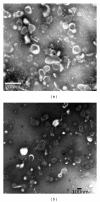Immunosuppressive exosomes: a new approach for treating arthritis
- PMID: 22548070
- PMCID: PMC3324137
- DOI: 10.1155/2012/573528
Immunosuppressive exosomes: a new approach for treating arthritis
Abstract
Rheumatoid arthritis (RA) is a chronic autoimmune disease and one of the leading causes of disability in the USA. Although certain biological therapies, including protein and antibodies targeting inflammatory factors such as the tumor necrosis factor, are effective in reducing symptoms of RA, these treatments do not reverse disease. Also, although novel gene therapy approaches have shown promise in preclinical and clinical studies to treat RA, it is still unclear whether gene therapy can be readily and safely applied to treat the large number of RA patients. Recently, nanosized, endocytic-derived membrane vesicles "exosomes" were demonstrated to function in cell-to-cell communication and to possess potent immunoregulatory properties. In particular, immunosuppressive DC-derived exosomes and blood plasma- or serum-derived exosomes have shown potent therapeutic effects in animal models of inflammatory and autoimmune disease including RA. This paper discusses the current knowledge on the production, efficacy, mechanism of action, and potential therapeutic use of immunosuppressive exosomes for arthritis therapy.
Figures


References
-
- Robbins PD, Evans CH, Chernajovsky Y. Gene therapy for arthritis. Gene Therapy. 2003;10(10):902–911. - PubMed
-
- Mountz JD, Chen J, Hsu HC. Rheumatoid arthritis: safe and sound. Gene Therapy. 2005;12:1542–1543. - PubMed
-
- Tomita T, Takeuchi E, Tomita N, et al. Suppressed severity of collagen-induced arthritis by in vivo transfection of nuclear factor κB decoy oligodeoxynucleotides as a gene therapy. Arthritis and Rheumatism. 1999;42(12):2532–2542. - PubMed
LinkOut - more resources
Full Text Sources
Other Literature Sources

